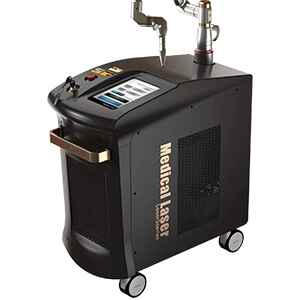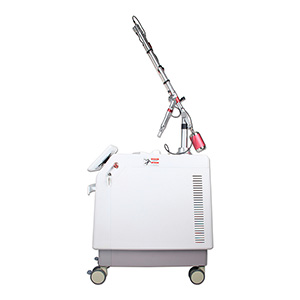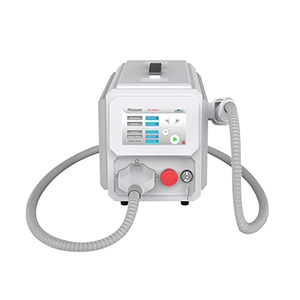Tattoo Removal Machines
Laser tattoo removal machines use laser light to remove a tattoo from your skin. They have different frequency and intensity levels to remove almost any sort of tattoos. There are a wide variety of tattoo removal machines available in the market, each with its unique features.
Nearly 30% of people in the world. have at least one tattoo. Almost half of all millennials have one. But not all of them are happy about their decision. As many as 25% of those with a tattoo say they regret getting it.
If you’re in that 25%, there is good news. Laser tattoo removal techniques can get rid of your unwanted tattoo with minimal side effects.
How It Works
Lasers remove tattoos by breaking up the pigment colors with a high-intensity light beam. Black tattoo pigment absorbs all laser wavelengths, making it the easiest color to treat. Other colors can only be treated by selected lasers based on the pigment color.
You should first schedule a consultation with a trained professional who can evaluate your tattoo and advise you on the process. The number of treatments you will need will depend on the age, size, and color(s) of your tattoo. The color of your skin, as well as how deep the tattoo pigment goes, will also affect the removal technique.

In general, this is what you should expect during a laser tattoo removal session:
- You’ll be given a pair of protective eye shields.
- The technician will test your skin’s reaction to the laser to determine the most effective energy for treatment.
- The technician uses the laser to pass pulses of intense light through the top layers of your skin that will be absorbed by the tattoo pigment only.
- Smaller tattoos will require fewer pulses while larger ones will need more to remove them. In either case, to completely get rid of a tattoo, it will take several treatments. After each visit, your tattoo should become progressively lighter.
- Laser tattoo removal is uncomfortable, but most patients don’t need anesthesia. Depending on the location of your tattoo, you may want to apply a topical anesthesia cream beforehand.
- Immediately following the treatment, use an ice pack to soothe the treated area. And apply an antibiotic cream or ointment and bandage to protect it. You should also be sure it’s covered with sunblock when you’re outside.
Technology
Peak Power
Power matters for getting quality tattoo removal results with each treatment. Some systems may provide adequate fading results for the first few treatments but do not have sufficient power to break up the ink of stubborn tattoos deep within the dermis. To avoid this problem, it is important to consider peak power as you make your laser purchasing decision.
Peak power is a result of pulse width and energy – the smaller the pulse width and the greater the energy production, the higher the peak power. Higher peak power levels allow practitioners to treat tattoos at greater fluences without compromising on laser treatment spot size. In all, peak power allows you to get better removal results for increased patient satisfaction.
Both the Q switch laser and the ND yag laser feature high levels of energy production and exceptionally short pulse widths for best-in-class peak power production. Make sure to consider peak power as you make your laser purchasing decision.
Wavelengths
Different colors of tattoo ink absorb different wavelengths of energy – meaning that tattoo removal practitioners switch between different wavelengths of laser energy when treating tattoos. Understanding the capabilities of different wavelengths will greatly guide your choice of laser.
There are three common types of Q-switched lasers in the tattoo removal industry: Nd: YAG, Ruby, and Alexandrite.
The go-to laser for most tattoo removal practitioners is an Nd: YAG laser, such as the s-qwitch, because it is capable of producing the most versatile wavelengths: 1064 nm and 532 nm. The 1064 nm wavelength is a powerhouse for treating black, blue, and other dark ink colors; the 532 nm wavelength is highly effective for removing red, orange, pink, and other bright colors. These two powerful wavelengths can completely remove 95% of tattoos.
Elite practitioners who are worried about the remaining 5% of tattoos often invest in an additional Ruby laser (694 nm), such as the sqwitch, or Alexandrite laser (755 nm) to compliment their purchase of an Nd: YAG laser. Both Ruby and Alexandrite wavelengths function very similarly and are excellently absorbed by difficult-to-treat ink colors such as lime green, teal, and turquoise.
The Q switch Trinity system – which combines the versatility of an Nd :YAG laser with the unique capabilities of a Ruby laser – is a powerful option for clinics looking to have the best of both types of lasers. The important difference between the Trinity and other multi-wavelength tattoo removal systems is that it has exceptionally powerful pulses for each wavelength. Be wary of “handpiece filter” systems that tout additional wavelengths but fail to deliver on power.
Laser Maintenance
Advanced actively Q-switched tattoo removal lasers require regular maintenance to perform at their best. These advanced laser systems have delicate technical and optical components that need periodic cleaning, calibration, and alignment. Without preventative maintenance and service by trained professionals, tattoo removal equipment will have a reduction in power and efficacy over time.
Because you probably plan to be performing tattoo removal for many years to come, it is important to choose a laser supplier that will provide ongoing service beyond the warranty expiration. After all, your tattoo removal laser is the cornerstone of your practice.
Some laser manufacturers do not offer a la carte services, which means that if you aren’t under an extended warranty contract, they will not service your laser if it fails. Similarly, used laser dealers typically do not provide any maintenance or service support, and the original manufacturers of the used system may not agree to provide service.
Unlike other manufacturers that either gouge customers with outrageous contract costs or neglect to provide responsive, quality technical support, Qswitch stands by our systems with ongoing service support by in-house expert technicians. To learn more about q-switch fair, and responsible service commitment to customers, please visit our Technical Support page.
Q-Switching
The technology used for tattoo removal procedures is called “Q-switching.” It is the production of a specific type of quick, powerful pulse that shatters tattoo ink without harming surrounding skin tissue. To learn more technical details about this advanced technology, please visit our Q-switch Laser Technology page.
All other types of aesthetic lasers will not safely and effectively remove tattoos – Q-switched lasers are the only proven method for removing tattoos safely without scarring.
There are two main types of Q-switched lasers on the market: passively Q-switched and actively Q-switched. Passively Q-switched lasers produce pulses of energy capable of removing tattoos but do not have the high-performance capabilities of larger, actively Q-switched laser systems.
Passively Q-switched lasers are generally smaller, more portable, and more affordable, but do not have the advanced power and features of actively Q-switched models. However, the Astanza Revolution is a passively Q-switched laser with exceptionally reliable pulses that far surpass the power creation of other passively Q-switched lasers.
The switch is an example of an actively Q-switched laser – each pulse is merely 6000 picoseconds in length for peak power many times greater than competing actively Q-switched laser systems. The high peak power from a professional-grade system allows for the removal of the most stubborn and difficult-to-treat tattoos.
The advantages of laser tattoo removal machine
Whatever you buy, there are certain things you need to consider if you are buying that thing for the very first time. The same is the case of buying a tattoo removal machine. There are tons of these machines available to be bought but to get you the best tattoo removal machine, we have several tips that you can consider before buying.
- Great for removing tattoos, acne marks, and freckles.
- It’s quite comfortable and convenient to use.
- Perfectly safe
- Available at an affordable price
- Quick and non-surgical treatment for old tattoos
What is the cost of professional vs home treatment?
If you are planning to remove your tattoos by professional treatment, then the cost you should keep in mind is between $200 and $500.
The number of treatments that you will get depends on the size, color, etc. of the tattoo.
Your skin color also matters in this case.
If you have a small tattoo that is dark in color, you might have to pay for just a few treatments.
But if you have a huge colorful tattoo, it might cost you thousands of dollars.
However, if you choose to remove your tattoo on your own at your home, you will save thousands of dollars.
All you need to do is to buy the best laser tattoo removal machine.
Normally, a good tattoo removal machine will cost you around $1000-$2500.
This is greatly cheap as compared to professional treatment.
Most of the machines available for the general public are the same as the ones available in the doctor’s office or the spa near you.
Hence, you will get almost the same treatment and you will save a hell lot of money as well!
The laser tattoo removal machine reviews:
How long will it take to remove the tattoo completely?
The duration of the removal of your tattoo varies as it depends on various factors.
Removing a tattoo requires various treatment sessions depending on the color and size of the tattoo.
The light colors will take more treatments than dark colors.
Your tattoo will take some time to get properly removed as you have to wait for your skin to heal between treatments.
Does tattoo removal using a laser hurt?
Laser tattoo removal hurts a bit but not a lot.
People often get frightened of the idea of removing their tattoos because of the pain they expect they will experience.
Removing a tattoo can cause pain similar to the one you experienced while the tattoo was being applied.
The pain is uncomfortable but still, you will be able to bear it.
Will the tattoo removal process leave a permanent scar?
It all depends on how properly you do the removal.
If you don’t keep the side effects in mind and use weird strategies to get the tattoo off your skin, you might get some scars.
The most common side effects in tattoo removal and healing process are blisters and scabs.



